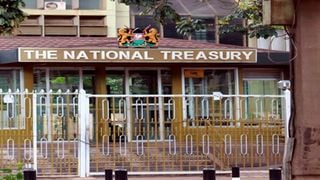
The National Treasury building in Nairobi.
| File | Nation Media GroupFinance and Markets
Premium
Debt mountain rises as Treasury borrows Sh3.3bn per day
The Treasury borrowed an average of Sh3.3 billion per day in the first two months of the current financial year, raising the total debt load by Sh200.3 billion between July and August.
The increased borrowing appetite comes even as the International Monetary Fund (IMF), in a new report, classified Kenya among countries posing high risk of debt default.
The international lender first downgraded Kenya’s ability to absorb more debt in May last year by elevating the country’s likelihood of defaulting on its external loans from moderate to high, as well as raising Nairobi’s overall risk of debt distress.
IMF, in a joint Debt Sustainability Analysis (DSA) with the World Bank, attributed the change in Kenya’s status to the impact of the Covid-19 pandemic that had ground the crucial export market, and also sullied the local business environment across critical sectors of the economy including tourism and hospitality, transport and trade.
Debt distress
“The risk of debt distress has moved to high from moderate due to the impact of the global Covid-19 crisis which exacerbated existing vulnerabilities. The Covid-19 crisis has led to a sharp decline in export and economic growth,” IMF said.
The lender added: “Addressing the crisis has required a strong fiscal response from the authorities that has also increased budget deficits. Consequently, a number of debt indicators have worsened. Kenya’s external and public debt vulnerabilities also reflect the high deficits of the past, including due to a decline in tax revenues as a share of GDP in recent years.”
But Kenya’s latest borrowing binge comes even as the exchequer expects to borrow a total of Sh661.6 billion from the local market over the course of the financial year, to add to the Sh379.6 billion loans from external lenders over the same period.
Debt ceiling
The borrowing spree means that Kenya’s debt, which hit Sh7.71 trillion in June, will spiral to Sh8.75 trillion by the close of the fiscal year, just Sh250 billion shy of hitting the statutory Sh9 trillion debt ceiling that will trigger a requirement to seek Parliament’s vote to further raise the debt ceiling.
The Treasury has already spent Sh162.3 billion on debt repayments over the past two months, which is Sh4 billion more than the Sh158.9 billion the entire government ministries, departments and agencies have received for recurrent expenditure during the same period.
A paltry Sh32.7 billion, meanwhile, has been used on development expenditure in that time, reflecting the extent to which debt, salaries and pensions have jeopardised job creation and funding of crucial social programmes.
These numbers make a grim reading for the Kenyan taxpayer in a year when Sh1.17 trillion is to be used to repay debt against a targeted tax revenue collection of Sh1.7 trillion, which means that for every Sh100 collected in tax by the Kenya Revenue Authority (KRA), Sh70 will be used to pay debt.
But the government’s borrowing appetite, especially from the local market, has bigger consequences yet both in the formal and informal sectors of the economy.
Just over half of the entire stock of domestic debt is sourced from local banks, which, faced with a record-breaking increase in bad loans due to the Covid-19 pandemic that badly affected businesses, now prefer lending their billions to the risk-free government.
This means that cash that could have been used in reviving or keeping struggling companies afloat is being swallowed by the government, leading to a slow economic recovery and therefore putting thousands of households on the brink.
Fuel subsidy
The cash crunch at the Treasury has also seen the government discontinue the fuel subsidy scheme that has been keeping fuel prices stable since April to alleviate a further rise in the cost of living, which consequently saw fuel prices rise to a historic high last week in the latest review by the energy regulator.
The State has been tapping funds from the Petroleum Development Levy Fund, whose cut was raised last year by Sh5, to pay oil marketing companies to keep fuel prices stable but has been removed to let consumers pay for the fuel increase from their pockets.
The new prices have pushed the price of a litre of petrol in Nairobi to Sh134.72, Sh115.60 for diesel while a litre of kerosene goes for Sh110.82. This has already seen the energy regulator announce an increase in electricity prices this month, while the cost of basic goods is also expected to rise in tandem with transportation costs.





